Effects of Hygrothermal Aging and Cyclic Compressive Loading on the Mechanical and Electrical Properties of Conductive Composites
Abstract
:1. Introduction
2. Materials and Methods
2.1. Materials
2.2. Preparation of the Test Samples
2.3. Hydrothermal Aging
2.4. Strain Sensing Experiment
2.5. Characterization
3. Results and Discussion
3.1. Mass Variation Curve
3.2. Analysis of the Results of Strain-Sensing Experiments
3.3. SEM Results
3.4. Dynamic Mechanical Properties
4. Conclusions
Author Contributions
Funding
Institutional Review Board Statement
Data Availability Statement
Conflicts of Interest
Appendix A

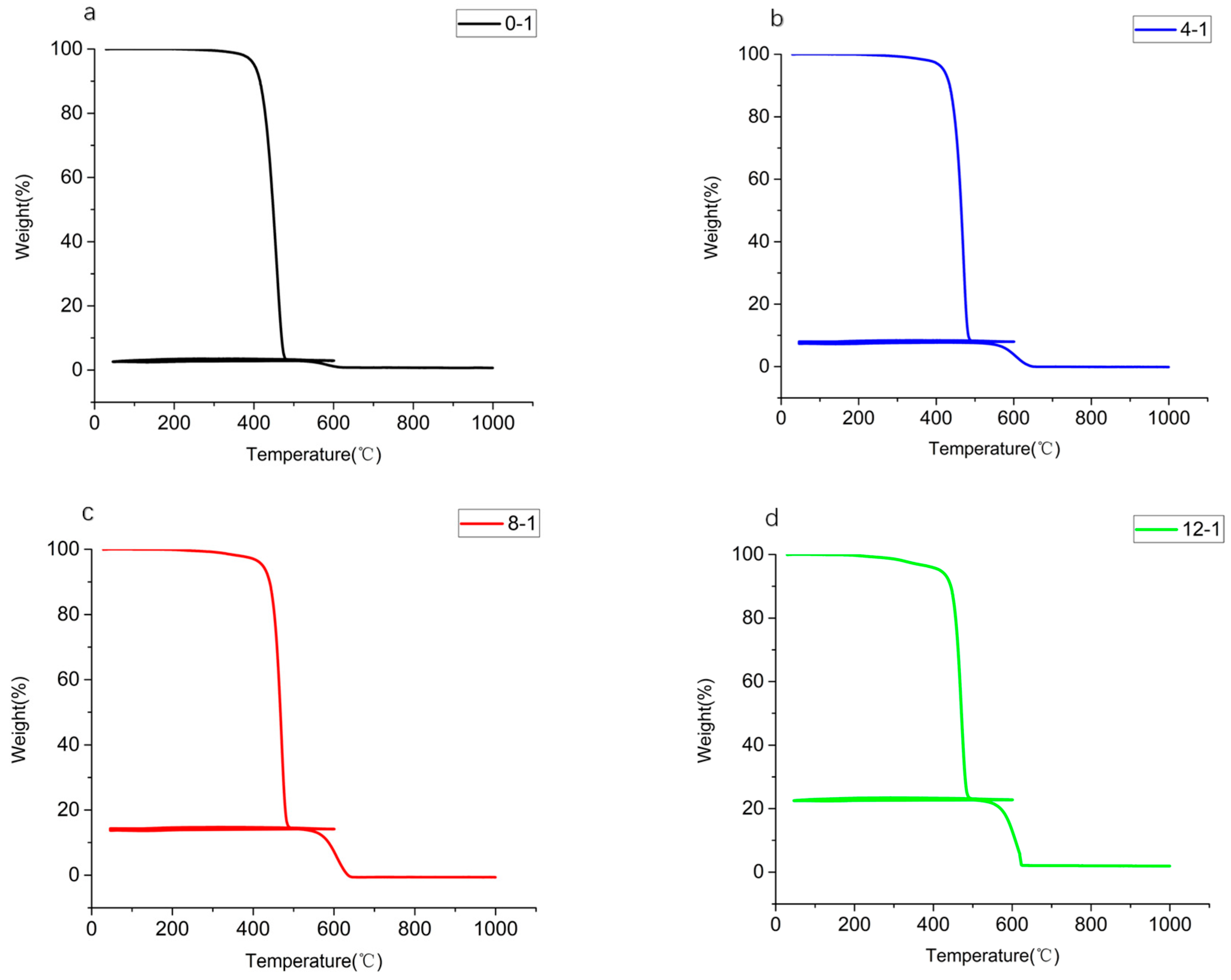

References
- Kim, S.; Amjadi, M.; Lee, T.-I.; Jeong, Y.; Kwon, D.; Kim, M.S.; Kim, K.; Kim, T.-S.; Oh, Y.S.; Park, I. Wearable, ultrawide-range, and bending-insensitive pressure sensor based on carbon nanotube network-coated porous elastomer sponges for human interface and healthcare devices. ACS Appl. Mater. Interfaces 2019, 11, 23639–23648. [Google Scholar] [CrossRef]
- Lee, S.; Reuveny, A.; Reeder, J.; Lee, S.; Jin, H.; Liu, Q.; Yokota, T.; Sekitani, T.; Isoyama, T.; Abe, Y. A transparent bending-insensitive pressure sensor. Nat. Nanotechnol. 2016, 11, 472–478. [Google Scholar] [CrossRef]
- Liu, Z.; Zheng, Y.; Jin, L.; Chen, K.; Zhai, H.; Huang, Q.; Chen, Z.; Yi, Y.; Umar, M.; Xu, L. Highly breathable and stretchable strain sensors with insensitive response to pressure and bending. Adv. Funct. Mater. 2021, 31, 2007622. [Google Scholar] [CrossRef]
- Allaoui, A.; Bai, S.; Cheng, H.-M.; Bai, J. Mechanical and electrical properties of a MWNT/epoxy composite. Compos. Sci. Technol. 2002, 62, 1993–1998. [Google Scholar] [CrossRef]
- Wichmann, M.H.; Buschhorn, S.T.; Gehrmann, J.; Schulte, K. Piezoresistive response of epoxy composites with carbon nanoparticles under tensile load. Phys. Rev. B Condens. Matter 2009, 80, 245437. [Google Scholar] [CrossRef]
- Vertuccio, L.; Guadagno, L.; Spinelli, G.; Lamberti, P.; Tucci, V.; Russo, S. Piezoresistive properties of resin reinforced with carbon nanotubes for health-monitoring of aircraft primary structures. Compos. Part B 2016, 107, 192–202. [Google Scholar] [CrossRef]
- Ma, P.-C.; Liu, M.-Y.; Zhang, H.; Wang, S.-Q.; Wang, R.; Wang, K.; Wong, Y.-K.; Tang, B.-Z.; Hong, S.-H.; Paik, K.-W. Enhanced electrical conductivity of nanocomposites containing hybrid fillers of carbon nanotubes and carbon black. ACS Appl. Mater. Interfaces 2009, 1, 1090–1096. [Google Scholar] [CrossRef]
- Khan, L.A.; Nesbitt, A.; Day, R.J. Hygrothermal degradation of 977-2A carbon/epoxy composite laminates cured in autoclave and Quickstep. Compos. Part A 2010, 41, 942–953. [Google Scholar] [CrossRef]
- Li, Y.; Miranda, J.; Sue, H.-J. Hygrothermal diffusion behavior in bismaleimide resin. Polymer 2001, 42, 7791–7799. [Google Scholar] [CrossRef]
- Parker, M.J. Test Methods for Physical Properties—ScienceDirect. Compr. Compos. Mater. II 2000, 5, 183–226. [Google Scholar]
- Marcuello, C.; Foulon, L.; Chabbert, B.; Molinari, M.; Aguié-Béghin, V. Langmuir–Blodgett Procedure to Precisely Control the Coverage of Functionalized AFM Cantilevers for SMFS Measurements: Application with Cellulose Nanocrystals. Langmuir 2018, 34, 9376–9386. [Google Scholar] [CrossRef]
- Berzin, F.; Lemkhanter, L.; Marcuello, C.; Chabbert, B.; Aguié-Béghin, V.; Molinari, M.; Castellani, R.; Vergnes, B. Influence of the polarity of the matrix on the breakage mechanisms of lignocellulosic fibers during twin-screw extrusion. Polym. Compos. 2020, 41, 1106–1117. [Google Scholar] [CrossRef]
- Fan, W.; Li, J.-l.; Zheng, Y.-y.; Liu, T.-j.; Tian, X.; Sun, R.-j. Influence of thermo-oxidative aging on the thermal conductivity of carbon fiber fabric reinforced epoxy composites. Polym. Degrad. Stab. 2016, 123, 162–169. [Google Scholar] [CrossRef]
- Ma, S.; He, Y.; Hui, L.; Xu, L. Effects of hygrothermal and thermal aging on the low-velocity impact properties of carbon fiber composites. Adv. Compos. Mater. 2020, 29, 55–72. [Google Scholar] [CrossRef]
- Glaskova-Kuzmina, T.; Zotti, A.; Borriello, A.; Zarrelli, M.; Aniskevich, A. Basalt fibre composite with carbon nanomodified epoxy matrix under hydrothermal ageing. Polymers 2021, 13, 532. [Google Scholar] [CrossRef]
- Ding, S.; Han, B.; Dong, X.; Yu, X.; Ni, Y.; Zheng, Q.; Ou, J. Pressure-sensitive behaviors, mechanisms and model of field assisted quantum tunneling composites. Polymer 2017, 113, 105–118. [Google Scholar] [CrossRef] [Green Version]
- Glaskova-Kuzmina, T.; Aniskevich, A.; Papanicolaou, G.; Portan, D.; Zotti, A.; Borriello, A.; Zarrelli, M. Hydrothermal aging of an epoxy resin filled with carbon nanofillers. Polymers 2020, 12, 1153. [Google Scholar] [CrossRef]
- Zhang, C.; Sun, L.; Huang, B.; Yang, X.; Chu, Y.; Zhan, B. Electrical and mechanical properties of CNT/CB dual filler conductive adhesives (DFCAs) for automotive multi-material joints. Compos. Struct. 2019, 225, 111183. [Google Scholar] [CrossRef]
- Kazemi, Y.; Kakroodi, A.R.; Wang, S.; Ameli, A.; Filleter, T.; Pötschke, P.; Park, C.B. Conductive network formation and destruction in polypropylene/carbon nanotube composites via crystal control using supercritical carbon dioxide. Polymer 2017, 129, 179–188. [Google Scholar] [CrossRef]
- Maurin, R.; Perrot, Y.; Bourmaud, A.; Davies, P.; Baley, C. Seawater ageing of low styrene emission resins for marine composites: Mechanical behaviour and nano-indentation studies. Composites Part A 2009, 40, 1024–1032. [Google Scholar] [CrossRef] [Green Version]
- Mehrer, H. Diffusion in Solids: Fundamentals, Methods, Materials, Diffusion-Controlled Processes; Springer Science & Business Media: Berlin, Germany, 2007; Volume 155. [Google Scholar]
- Marsh, L.; Lasky, R.; Seraphim, D.; Springer, G. Moisture solubility and diffusion in epoxy and epoxy-glass composites. IBM J. Res. Dev. 1984, 28, 655–661. [Google Scholar] [CrossRef]
- Prolongo, S.; Gude, M.; Ureña, A. Water uptake of epoxy composites reinforced with carbon nanofillers. Compos. Part A 2012, 43, 2169–2175. [Google Scholar] [CrossRef]
- Chen, L.; Chen, G.; Lu, L. Piezoresistive behavior study on finger-sensing silicone rubber/graphite nanosheet nanocomposites. Adv. Funct. Mater. 2007, 17, 898–904. [Google Scholar] [CrossRef]
- Kost, J.; Narkis, M.; Foux, A. Resistivity behavior of carbon-black-filled silicone rubber in cyclic loading experiments. J. Appl. Polym. Sci. 1984, 29, 3937–3946. [Google Scholar] [CrossRef]
- Qiu, L.; Bulut Coskun, M.; Tang, Y.; Liu, J.Z.; Alan, T.; Ding, J.; Truong, V.T.; Li, D. Ultrafast dynamic piezoresistive response of graphene-based cellular elastomers. Adv. Mater. 2016, 28, 194–200. [Google Scholar] [CrossRef]
- Han, B.; Han, B.; Ou, J. Experimental study on use of nickel powder-filled Portland cement-based composite for fabrication of piezoresistive sensors with high sensitivity. Sens. Actuators A 2009, 149, 51–55. [Google Scholar] [CrossRef]
- Simmons, J.G. Generalized formula for the electric tunnel effect between similar electrodes separated by a thin insulating film. J. Appl. Phys. 1963, 34, 1793–1803. [Google Scholar] [CrossRef] [Green Version]
- Ye, D.; Moussa, S.; Ferguson, J.D.; Baski, A.A.; El-Shall, M.S. Highly efficient electron field emission from graphene oxide sheets supported by nickel nanotip arrays. Nano Lett. 2012, 12, 1265–1268. [Google Scholar] [CrossRef]
- Hernandez, J.; Kedir, N.; Lim, B.H.; Chen, W.; Tallman, T. An experimental study on the piezoresistive and mechanical behavior of carbon nanocomposites subject to high-rate elastic loading. Compos. Sci. Technol. 2020, 198, 108285. [Google Scholar] [CrossRef]
- Starkova, O.; Mannov, E.; Schulte, K.; Aniskevich, A. Strain-dependent electrical resistance of epoxy/MWCNT composite after hydrothermal aging. Compos. Sci. Technol. 2015, 117, 107–113. [Google Scholar] [CrossRef]
- Xu, L.; He, Y.; Ma, S.; Hui, L.; Jia, Y.; Tu, Y. Effects of aging process and testing temperature on the open-hole compressive properties of a carbon fiber composite. High Perform. Polym. 2020, 32, 693–701. [Google Scholar] [CrossRef]
- Sun, S.; Chen, S.; Weng, X.; Shan, F.; Hu, S. Effect of carbon nanotube addition on the interfacial adhesion between graphene and epoxy: A molecular dynamics simulation. Polymers 2019, 11, 121. [Google Scholar] [CrossRef] [PubMed] [Green Version]
- Nazarychev, V.M.; Vaganov, G.V.; Larin, S.V.; Didenko, A.L.; Elokhovskiy, V.Y.; Svetlichnyi, V.M.; Yudin, V.E.; Lyulin, S.V. Rheological and Mechanical Properties of Thermoplastic Crystallizable Polyimide-Based Nanocomposites Filled with Carbon Nanotubes: Computer Simulations and Experiments. Polymers 2022, 14, 3154. [Google Scholar] [CrossRef]
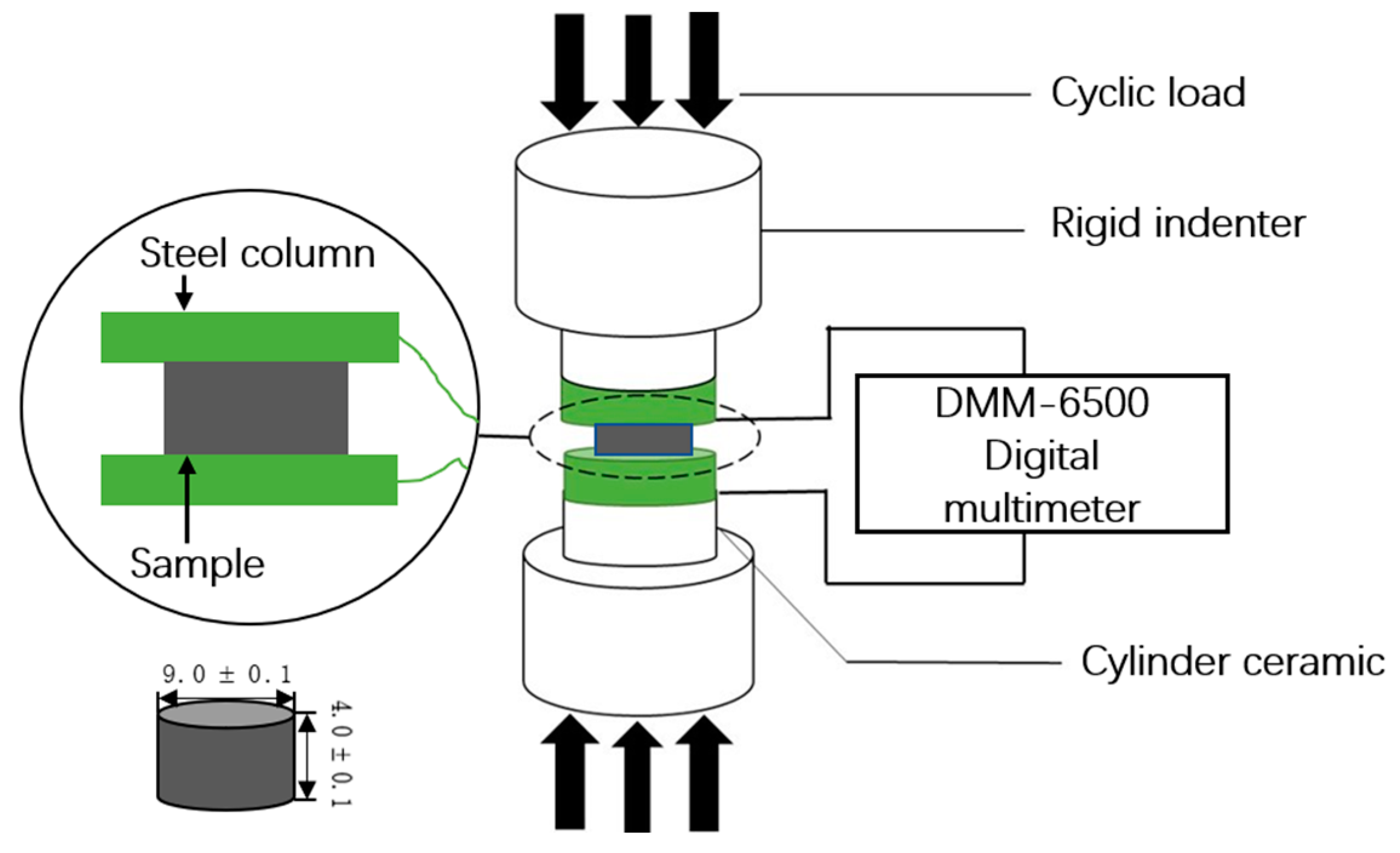


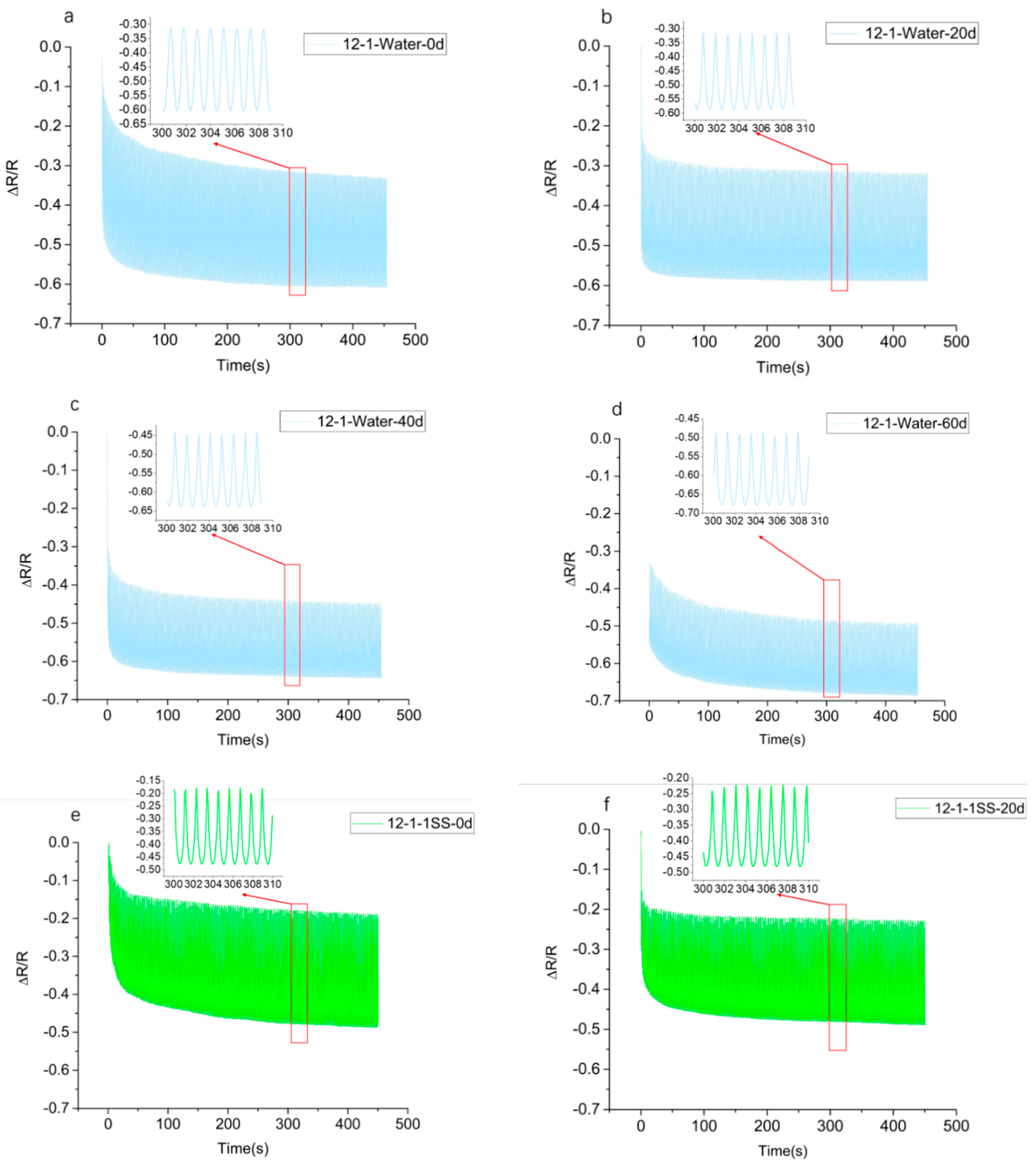
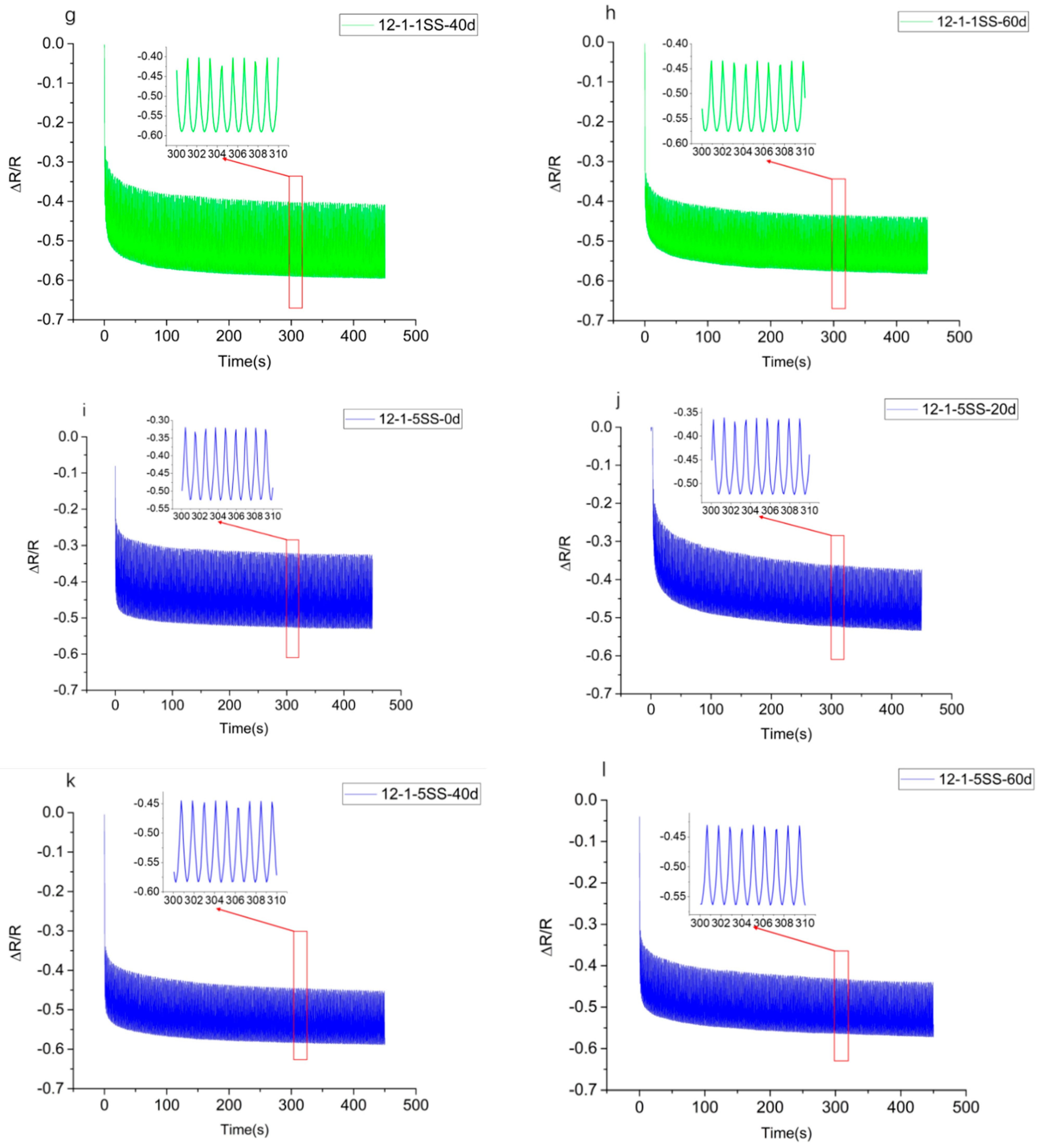


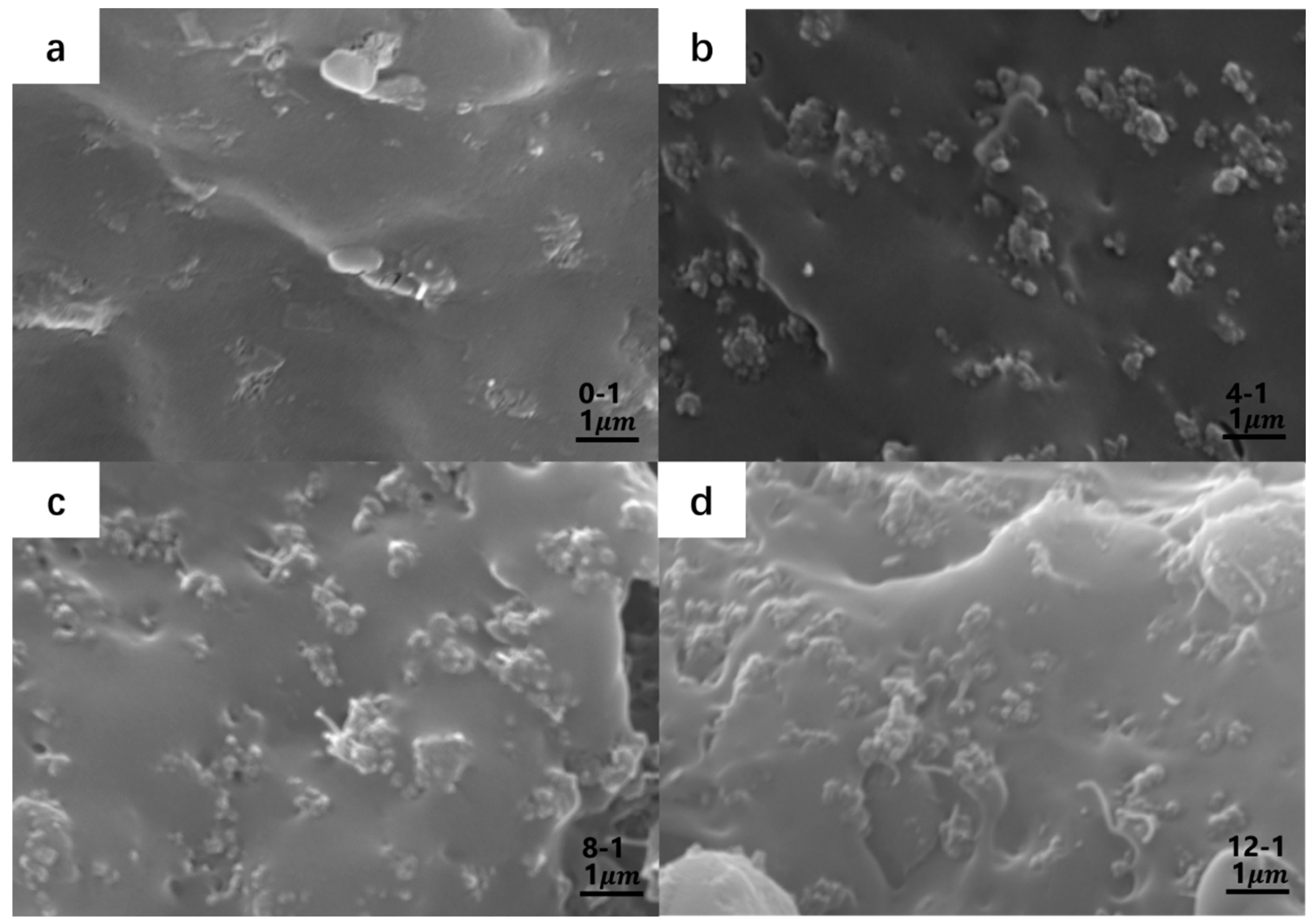

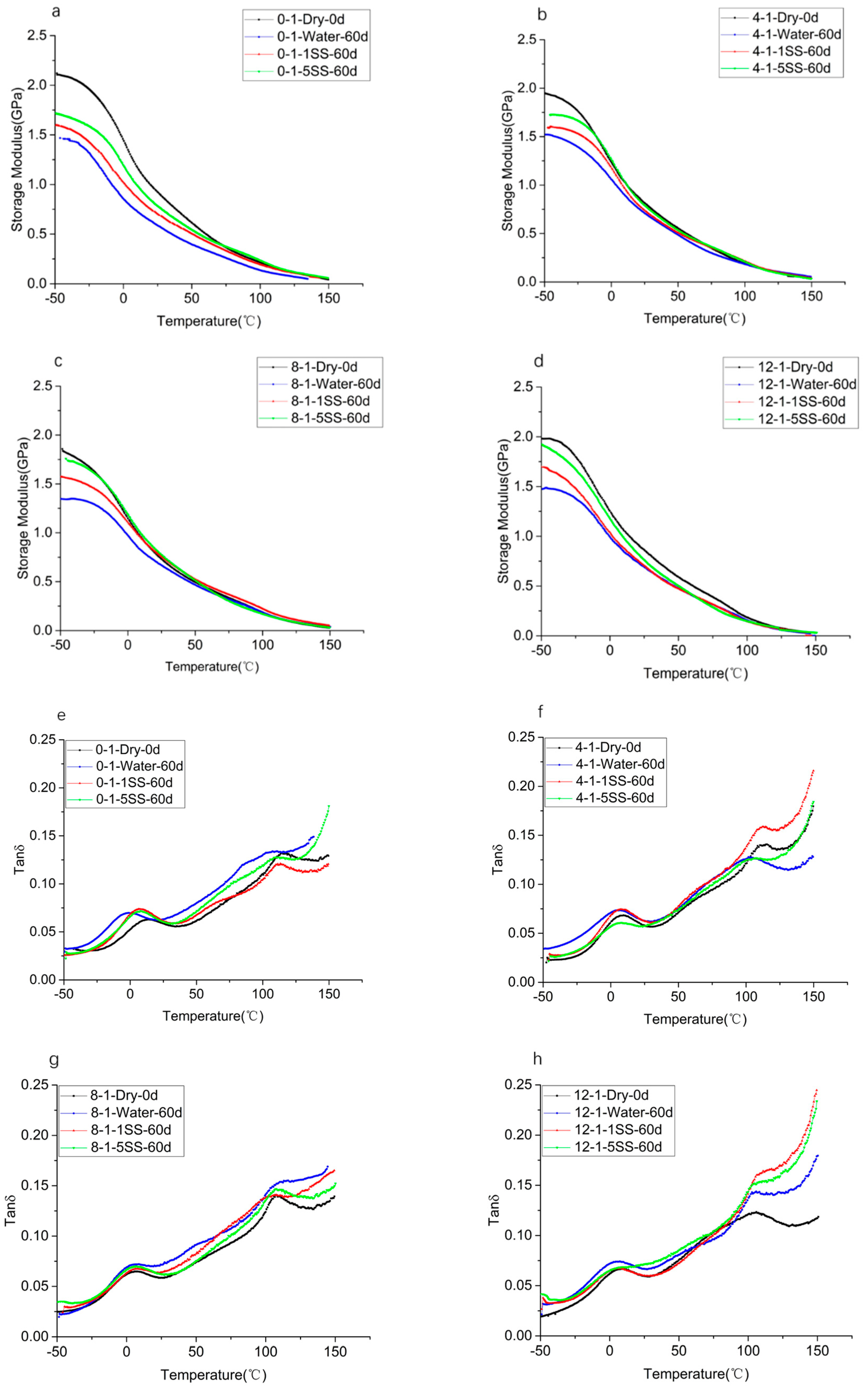
| Content | 0-1 | 4-1 | 8-1 | 12-1 |
|---|---|---|---|---|
| CB Vol% | 0 | 4 | 8 | 12 |
| MWCNTs Vol% | 1 | 1 | 1 | 1 |
| Solution | 0-1 | 4-1 | 8-1 | 12-1 |
|---|---|---|---|---|
| Water | 0.082 | 0.112 | 0.219 | 0.238 |
| 1SS | 0.069 | 0.064 | 0.121 | 0.206 |
| 5SS | 0.037 | 0.032 | 0.101 | 0.153 |
| Solution | Dry | 20 Days | 40 Days | 60 Days |
|---|---|---|---|---|
| Water | 3.5 | 3.3 | 2.4 | 2.3 |
| 1SS | 3.6 | 3.1 | 2.3 | 1.7 |
| 5SS | 2.5 | 2.2 | 1.9 | 1.6 |
Publisher’s Note: MDPI stays neutral with regard to jurisdictional claims in published maps and institutional affiliations. |
© 2022 by the authors. Licensee MDPI, Basel, Switzerland. This article is an open access article distributed under the terms and conditions of the Creative Commons Attribution (CC BY) license (https://creativecommons.org/licenses/by/4.0/).
Share and Cite
Yi, S.; Xie, L.; Wu, Z.; Ning, W.; Du, J.; Zhang, M. Effects of Hygrothermal Aging and Cyclic Compressive Loading on the Mechanical and Electrical Properties of Conductive Composites. Polymers 2022, 14, 5089. https://doi.org/10.3390/polym14235089
Yi S, Xie L, Wu Z, Ning W, Du J, Zhang M. Effects of Hygrothermal Aging and Cyclic Compressive Loading on the Mechanical and Electrical Properties of Conductive Composites. Polymers. 2022; 14(23):5089. https://doi.org/10.3390/polym14235089
Chicago/Turabian StyleYi, Shuwang, Long Xie, Zhi Wu, Weiming Ning, Jianke Du, and Minghua Zhang. 2022. "Effects of Hygrothermal Aging and Cyclic Compressive Loading on the Mechanical and Electrical Properties of Conductive Composites" Polymers 14, no. 23: 5089. https://doi.org/10.3390/polym14235089





